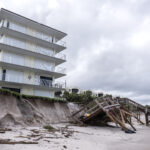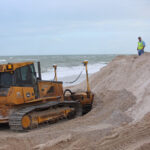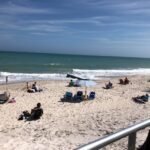By Lisa ZahnerINDIAN RIVER COUNTY — Officials tasked with protecting the sea turtle nesting grounds at Archie Carr National Wildlife Refuge are want proof that upland sand will allow turtles to thrive, so the Board of County Commissioners Tuesday agreed to only do about half the planned beach renourishment project this season.Of the original 6.6-mile stretch of beach, the northern part from Golden Sands Park to Treasure Shores Park falls within the wildlife refuge. The area from Golden Sands Park up to John’s Island will be tacked this season by trucking in more than 12,000 loads of sand, once permits are in hand, but permission to place upland sand on refuge beaches will have to wait until at least Nov. 2010.”For a while I had some doubts about the ability to get the project done in one season anyway,” said Bob Solari, who had voiced concerns about the county staff’s ambitious timetable banking on permit approval having an exceptionally quick turnaround. During the course of the design work on the project, Coastal Resources Manager Jonathan Gorham had told commissioners that the characteristics of the sand would need to be compatible in order to foster sea turtle nesting. The project design has been focused the past couple of months on the mean grain size of the sand, which determines how much sand will wash out onto the near-shore reef, also called the hardbottom. Other characteristics of the sand include the color — lighter sand absorbs less sunlight and is cooler while darker sand absorbs more sunlight and gets hotter — and how the sand performs once on the beach for a period of time.Gorham said the county staff would need to develop a tracking and testing plan to gather the required information on sea turtles to report back to the federal agencies. He said additional “quality control measures” had also been discussed during the meetings with regulators. Those meetings continue this week with a sit-down with officials from the Florida Department of Environmental Protection.”This will give us the opportunity to show the performance of the sand in relation to sea turtle nesting,” Gorham said.Upland sand providers have been hauling sand onto beaches in Florida for years in conjunction with new construction when stabilization is needed or the homes rest on pilings. Trucked-in sand has also been widely used for shoring up homes, hotels and restaurants after major Nor’easters and hurricanes. Stretching the project out will mean a lower volume of trucks on the beach this season, but it will also mean dumptrucks on the roads next season as well. Residents of Orchid and Indian River Shores have expressed concerns about the wear and tear of dumptrucks on the roads and bridges.”This gets the sand onto the beaches in the most needed areas,” said Chairman Wesley Davis.Should the data show that sea turtle did not successfully nest in the upland sand, the county may be faced with the decision of not renourishing that part of the beach or bringing in a dredge company to supply pumped-in sand from offshore, which would be cost-prohibitive for a smaller-scale project. Offshore sand was used in the 2007 project to stabilize beaches from the Sebastian Inlet State Park to Ambersands Beach and, county staff said, monitoring has shown that the turtles in the refuge “like” the offshore sand.In a separate action, commissioners approved a “letter of intent” to award the contract for the beach renourishment project to Fort-Pierce based Ranger Construction in the amount of $7.2 million. The actual signing of the contract will be contingent upon final permitting and notice to proceed being received for Phase 1 of the project from the FDEP and the Army Corps of Engineers.
Beach renourishment project will be cut in half for this season
previous post






